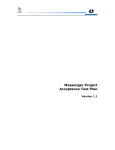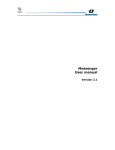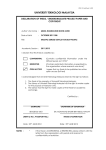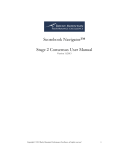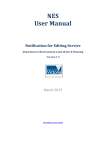Download Messenger Design Description
Transcript
Messenger
Design Description
Version 3.0
Messenger
Version:
Design Description
Date: 2004-12-17
3.0
Revision History
Date
Version
Description
Author
2004-11-24
1.0
Initial Draft
Jonas, Irfan, Zahid,
Zdenek, Tihana,
Marko
2004-12-10
2.0
Done the most of the re-doing of
this doc. Some comments left.
Zahid
2004-12-11
2.1
I have done some formatting on
the whole text plus making picture
out of the OSD to be able to
adjust the size f them to fit better
to page. I have added some
comments that need to be fixed.
Jonas
2004-12-11
2.2
Made some changes with
headings around heading 3
Zahid (via Jonas)
2004-12-15
2.3
Made new figure 2 in section 2.2.
In section 2.3.1 added more info
on shutdown program procedure.
In section 2.3.3 added some
explanation. In section 2.3.6
added some detailed description.
Spellchecked whole document.
Tihana
2004-12-15
2.4
Changed commentary on the web
pages. Add risk.
Zdenek
2004-12-15
2.5
Added pictures of predefined and
search tab. Made some minor
changes in the text (corrected
grammatical errors in section 2.3).
Marko
2004-12-17
2.6
Grammatical check and correction.
Changed
some
text.
Copied
introduction
from
req.
doc.
Rearranged positions and sizes of
pictures in Web interface chapter.
Marko
2004-12-16
3.0
Did the last formatting of the doc.
Jonas
the
Page 1
Messenger
Version:
Design Description
Date: 2004-12-17
3.0
Table of Contents
1.
1.1
1.2
1.3
1.4
1.5
2.
Introduction
3
Purpose of this document
Intended Audience
Scope
Definitions and acronyms
1.4.1
Acronyms and abbreviations
Related Documents
3
3
3
4
4
4
External interfaces
5
2.1
2.2
2.3
Software Architecture
System Decomposition
Graphical User Interface for the Messenger client
2.3.1
Main program window
2.3.2
Tabs
2.3.3
Menu
2.3.4
Icons
2.3.5
Cursors
2.3.6
System Tray Menu
2.4
Web Page
2.4.1
Graphical User Interface
3.
Detail Software Design
3.1
3.2
3.3
3.4
4.
5
6
8
8
9
12
12
12
13
14
14
21
Class Relationship diagram (CRD)
Object Sequence diagram
Database design description
Error handling
21
22
26
29
Approvals
29
Page 2
Messenger
Version:
Design Description
Date: 2004-12-17
1.
3.0
Introduction
Some communication between members in a software project leaves traces (such as
emails or protocols from meetings) that make it possible to retrieve information later on.
Other communication channels leave no trace. The task of this project is therefore to
store relevant chat sessions in a way so that this information can be easily retrieved
later. Though they sometimes do have an option to save a conversation, this option is
limited to individual saving. That means the information is available only to the
participant of this kind of conversation who actually saved the conversation. The other
participants can’t retrieve it unless they also saved it. This is however not formal
enough, because every team member should have accesses to the same relevant
information concerning the meetings, and this information should be secure. When each
team member saves the conversation him/herself locally in plain text format, data
manipulations are possible. Consider a case of some unscrupulous team member that is
capable of changing the text of conversations. This hypothetical team member gives
promises he can’t deliver and then later changes the text of conversations in order to
avoid responsibility for his actions. This hypothetical case can cause much harm to team
work in distributed software development process. The main goal of this project is
therefore to store relevant chat sessions in one place, regardless of the Instant
messenger participant’s use, so that all the participants can easily retrieve this
information later. The information stored should be secure, because of the formal
character of meetings.
1.1 Purpose of this document
The purpose of this document is to describe the design phase of the project. The
document describes the system architecture, structural design, low detail design and the
interfaces of the web and the messenger client. This document will be modified and
updated throughout the lifespan of this project.
1.2 Intended Audience
Our intended audience is:
•
Steering Group
•
Project staff
•
Class fellows and customer
1.3 Scope
The task of this project is to store relevant chat sessions in a way that this information
can be easily retrieved later. Project outputs will be development of a small daemon or
plug-in that runs locally and connects somehow to, or runs as a plug-in in any popular
chat messenger program such as ICQ, AIM, MSN messenger and Yahoo messenger.
Client program saves chat sessions in a central project database (e.g. MySQL or
PostgreSQL database).
Page 3
Messenger
Version:
Design Description
Date: 2004-12-17
3.0
1.4 Definitions and acronyms
1.4.1 Acronyms and abbreviations
Acronym
CRD
OSD
ID
STD
DB
Definitions
Class Relationship Diagram
Object Sequence Diagram
Interaction Diagram
State Transition Diagram
Database
1.5 Related Documents
Document identity
Document title
Project Description
Project description document
Requirements definition
Requirement Definition document
Page 4
Messenger
Version:
Design Description
Date: 2004-12-17
3.0
2. External interfaces
2.1 Software Architecture
Messenger software with its web interface is actually three-tier architecture where the
web pages are used to add new members/projects as well as search the chat sessions.
Messenger software will connect to the centralized database residing on the server and
save the conversations into related database tables. Whenever team members will start
chatting the system will store the chat locally and then onto the server. Figure 1.
explains the overall architecture and connectivity of the system to the server.
Figure 1: Architectural View
Page 5
Messenger
Version:
Design Description
Date: 2004-12-17
3.0
2.2 System Decomposition
Figure 2: System decomposition
Page 6
Messenger
Version:
Design Description
Date: 2004-12-17
3.0
This schematic represents modules in the source code of our project, and the way these
modules communicate. The module schematic has been inherited from the last year
project. Green dotted line outlines light green area that represents server side of our
application. Similarly, blue dotted line outlines light blue area that represents client side
of our application. Each module is colored into its own color. Outline is a darker shade,
and fill is somewhat lighter shade of that color. Thin arrows in outline color of a certain
module represent tasks executed by that object. Significant parts of some modules are
outlined in the same color as the module, but different shade of fills color. The thicker
arrows in red color mark standard communication protocols. The type of the protocol is
also given.
The MAIN module initializes LURKER module and initiates monitoring. LURKER module
checks all running processes for new infiltration targets. When it founds one (new
Messenger program) it loads defined dll file into target's process. It also keeps track of
already infiltrated Instant Messenger programs. The MESSENGER SPECIFIC module when
attached to an Instant messenger application (via hooks, or as a plug-in) gets messages
from Instant messenger and sends them to STARGATE module via shared memory. The
STARGATE module then transfers the message to MAIN module. The STARGATE module
provides synchronization for accessing shared memory, and takes care that messages
are not overwritten before module that they should be read by really reads them. MAIN
module is concerned with communicating with the user through an USER INTERFACE,
and also with Instant Message storage handling. DB COMMUNICATION client is in charge
of communication with a database on a server. LOCAL STORAGE CLIENT takes care of
storing the data locally. Storing is always done locally, and upon sending data to the
database, the data is erased locally. User can determine which conversations he wants
to be stored only locally. That way user can save all his conversations using one
application; regardless if they are part of the project or private nature. The SERVER
SIDE DATABASE COMMUNICATION DAEMON waits for a connection on a certain port,
and then transfferes all request to the database locally (as this two modules are on the
same server).
Page 7
Messenger
Version:
Design Description
Date: 2004-12-17
3.0
2.3 Graphical User Interface for the Messenger client
When program is run the Main program window should appear by default. All buttons or
any kind or other input fields, in any menu or window of this application, are grayish in
color when inactive (disabled).
2.3.1 Main program window
Figure 3. The Main window
Main window of the program GUI is composed of a Title Bar, Menu Bar and three Tabs in
the main area: Record Tab, Predefined Tab and Search Tab. Title Bar contains Name of
the program, and also three buttons: Minimize, Maximize/Restore Down and Close
Button, which is windows standard. Only exception from windows standard function
these perform is Close Window button, which does not close the program when clicked
on the Main window. Instead it minimizes the program to System Tray, as it is the
standard with Messenger Applications. There are two ways to close (shutdown) the
program: through Shutdown option in the Main Menu, or through the Shutdown option in
the system tray menu. The Main Menu is accessible through main program window, and
the system tray menu by right-clicking on the system tray icon.
Page 8
Messenger
Version:
Design Description
Date: 2004-12-17
3.0
2.3.2 Tabs
Users most common action is summarized into three groups, and should therefore be
implemented with Tabs in the main area of the Main window.
Record Tab is the first Tab, most common to use, and is therefore displayed by default
and it is divided into two areas: Chats list and Record Functions.
Chat list is similar with ICQ Contact list. It shows Chats currently being recorded first in
different color (red) with recording icon beside. Divided by the gray line from the upper
part, below is list available chats which are currently not being recorded (in green with
not-recording icon). The Chats in both parts of the list are selectable in the same way, as
selection of the files in a directory in Windows Explorer application, which are windows
standard.
Record Functions buttons: Record, Stop recording, Stop All and Send to Database
Button. Buttons are wide, have both icon and text assigned to appropriate function.
When one or more Chat/s from lower part of the Chat list (not-recording part) is selected
Record Button becomes active. Pressing this button will start recording process for
selected Chat/s. When one or more Chat/s from upper part of the Chat list (recording
part) is selected Stop Recording Button becomes active (it is grayish while inactive).
Pressing this button will initiate stop recording process for selected Chat/s.
This button is active when there are any Chats on a recording part of the Chat list (upper
part). Pressing this button will initiate stop recording process for all Chat/s in the
recording part of a Chat list. This button is always active. Pressing it will initiate sending
locally stored chat sessions to the database on the server.
Record tab can be seen in figure 3. on the page 7.
Predefined Tab serves as editor of presets in recording process. Here you can add nicks
from your Messenger Application Contact List, and preset the recording process for these
contacts. It is also possible to choose between two options: recording conversations with
multiple participants, when the contact is one of them, or recording "private" chats only
(4 eyes only). This tab is also divided into two parts. First part is a list of contacts that
already have the recording process preset. The other part consists of three Buttons:
Add, Edit and Remove Button.
List of contacts that already have the recording process preset, is a list type already
familiar from Windows environment. It has three fields: Nickname/Contact, Messenger,
Description and private ("4 eyes only") field. Nickname/Contact and Messenger fields are
automatically retrieved from the messenger when adding contacts. Description field can
be changed by the user (Edit button), but is left blank by default. Private ("4 eyes only")
is a checkbox field, which can be checked or unchecked, but is not checked by default.
Add button is always available. Pressing this button opens a new window with a
checkbox list of currently active Messenger Applications that are also supported by the
program. Below that simple list there is a Retrieve Button, which is active, when at least
one of the Messenger Application on the list, is selected. There is also a Cancel button.
Pressing the Retrieve button results in a new window with a checkbox list of
contacts/messenger pairs retrieved from selected Messenger/s that are not already on a
preset list. This window has also two buttons below that list: Add and Cancel. Add button
is inactive until at least one contact from the list is selected. When pressed this button
initiates the function which adds selected contact/messenger pairs to the preset list on
the Predefined tab in the main window.
Page 9
Messenger
Version:
Design Description
Date: 2004-12-17
3.0
Edit button is available when a contact from the preset list is selected. Pressing this
button brings out a form, where all the fields of the preset list can be changed.
Remove button is available when a contact from the preset list is selected. Pressing this
button removes selected contact/s from the preset list.
Predefined tab described above can be seen in the figure 4. below.
Figure 4. Predefined tab
Search tab contains a search form, used to retrieve information about stored
conversations. It has two parts. On the top part there are two checkboxes: Search Local
File and Search Database. These two are both checked by default (all combinations are
possible). When neither of these is checked the second part of this tab, except for Cancel
button, is disabled.
The second part is a form where user can enter search parameters. These are:
keyword/s field (textbox), username/nickname/contact field (textbox), time period input,
project drop down list, Search and Cancel buttons below. Time period input will probably
be a two calendars input for a date, and simple input for hours and minutes (small
textbox).
When user clicks on the Search button, new window appears containing Search results.
On that window there is a list of chats found (connected to multiple files in which chat is
stored - this is not viewable, but is known to the program). Also there are View and
Cancel buttons. User can select one or more chat/s from the list.
Page 10
Messenger
Version:
Design Description
Date: 2004-12-17
3.0
When the View button is pressed, program decrypts files in which selected chat/s is/are
stored, and it stores each chat into a temporary file (decrypted and merged files for each
chat). Then an external viewer, which opens them, is called.
Search tab described above can be seen in the figure 5. below.
Figure 5. Search tab
Page 11
Messenger
Version:
Design Description
Date: 2004-12-17
3.0
2.3.3 Menu
Menu Contains Shutdown function which shutdowns the program. Opens the Options
Window. Options Window has two tabs: General and Database Settings. All advanced
options such as external viewer location (Notepad by default), conversation storage
folder, ... Database Settings tab holds all options regarding the database like: username,
password, remember (encrypted) password checkbox, server location, etc. Clicking on
Help menu in this version will simply open the user manual in a default text viewer. This
could be changed in later versions, in a way that clicking on this menu would open a
standard Windows help window.
Standard About-Dialog is a simple message box which holds the information about the
version of a program (that is version number and/or name) and about its authors (that
is name of company or list of programmers).
2.3.4 Icons
Icon in system
• If there
• If there
• If there
tray should change color:
are some recording in progress
aren't any recording in progress, but there are chats available for record
aren't any chats in progress, but there is at least one Messenger
Application active
• If there aren't any Messenger Application active
2.3.5 Cursors
When some operation in progress, cursor should change to standard windows working
cursor (rotating sand clock).
Page 12
Messenger
Version:
Design Description
Date: 2004-12-17
3.0
2.3.6 System Tray Menu
Figure 6.
The System tray menu
The system tray menu is accessed by right-clicking the system tray icon. The menu
floats above system tray, and its options can be accessed through a left-click. Each of
the options either initiates some process or opens a relevant dialog (window). The
system tray menu contains following menu options:
• Open Main program window
- opens the Main program window
• Record/Stop
- opens the Main program window with Record tab in front
• Stop All Recording
- brings all currently active recordings to a stop
- program behaves in the same way, as the "Stop All Recording" button in the
Record Tab of the Main program window is pressed
- doesn't open the Main program window
• Preset
- opens the Main program window with Predefined tab in front
• Search
- opens the Main program window with Search tab in front
• Options
- opens the Options Window
• Help
- opens the User Manual in the default text editor
• About
- opens the Standard About Dialog (message box with program version and
authors)
• Shutdown
- initiates program shutdown
All of these options can be accessed in some other way, through the Main program
window.
Page 13
Messenger
Version:
Design Description
Date: 2004-12-17
3.0
2.4 Web Page
Customer wants a homepage with information about saved conversations related to the
projects and engine to search within the conversations. This document specifies the
design of the product.
2.4.1 Graphical User Interface
The actor has to log in. After log in actor can search for conversation s/he would like to
find. Administrator can also add new members and new projects. Super administrator
moreover is responsible for deleting members and projects.
Figure 7. depicts first page visible to user. This page represents log in page. Actor has to
type his/her username and password. Then click on login. The page will look on the
Internet like in the picture:
Figure 7.
The login page
Page 14
Messenger
Version:
Design Description
Date: 2004-12-17
3.0
Figure 8. depicts change password page, where actor can change his/her password.
Actor is obliged to change password after first log in. New password has to be from four
to sixteen characters long (cannot be same as login name). To save new password to
database user has to click to change.
Figure 8.
Change personal info page
Personal info page contains all relevant data about an actor. Actor can see all the data as
it is shown on the figure 9. He can also change and update data e.g. email, telephone
number, password etc. Actor is not allowed to change the project s/he is working in.
Figure 9.
Personal Info page
Page 15
Messenger
Version:
Design Description
Date: 2004-12-17
3.0
Search page is the core of all web pages. You can see its design in figure 10. Actor can
search for a conversation by criteria such as project name, project member keyword or
dates of conversations. For easier search project name and project member fields are
combo boxes. Also notice that format of dates is set. As you can see, on the left side of
the figure there is a hyperlink that refers to personal data.
Figure 10.
Search page
After running a search, user is transferred to a search result page. Design of this page is
shown in figure 11. A line divides selected conversations. To see the actual conversation,
actor was looking for, s/he has to click to the date of the conversation.
Figure 11.
Result page
Page 16
Messenger
Version:
Design Description
Date: 2004-12-17
3.0
Selected conversation is displayed like in figure 12. As you can see on the figure, lines
separate details about the conversation. Details displayed are: name of the project,
members who were in a conversation and date when conversation was saved. On the left
side of the page there are start, personal info and logout links. Clicking them actor can
either return to the search page, change the personal data or logout. In the figure it is
visible that the members’ lines are colored differently. This is done to make it easy for
actor to recognize different peoples’ chats.
Figure 12.
Conversation page
In figure 13. you can see how the left menu, when logged-in as administrator, differs
from user’s menu. Administrator can add and edit member and also add and edit project.
Figure 13 shows add member when administrator adds new members.
Figure 13.
Add member page for administrator
Page 17
Messenger
Version:
Design Description
Date: 2004-12-17
3.0
Edit member page, which is shown in the figure 14, gives administrator rights to change
the details about a user. Administrator can also, on this page, add a user to another
project.
Figure 14.
Edit member page for administrator
Figure 15 shows how administrator sees add project page. On this page administrator
adds a project to the database with all the details about the project such as start and
end date and the members of the project. To add more members administrator has to
press CTRL + click on the name of the member that will be involved in the project. When
all the details are chosen administrator saves project to the database by clicking on add.
Figure 15.
Add project page for administrator
Page 18
Messenger
Version:
Design Description
Date: 2004-12-17
3.0
Administrator uses edit project page to change details about project or to add and
remove members from project. This is depicted in figure 16. Administrator adds or
removes members from project by holding CTRL and clicking on member’s names. To
update information s/he needs to press update when finished.
Figure 16.
Edit project page for administrator
Difference between result page when logged in as user or as administrator and super
administrator exists only in left panel. Administrator and super administrator can also
choose from add and edit possibilities as it is displayed in the figure 17. Conversation
page also differs only in the left side.
Figure 17.
Result page for administrator, super administrator
Page 19
Messenger
Version:
Design Description
Date: 2004-12-17
3.0
Web pages differ when logged in as administrator and super administrator. Difference is
visible in member page where only super administrator can delete members and all their
records. As you can see in the figure 18 next to each project name delete link is placed.
When super administrator clicks to this link member’s account is locked. This means that
only his/her name is deleted from the project table. Conversations, in which user
participated, remain in database.
Figure 18.
Edit member page for super administrator
In edit project page, depicted in figure 19, super administrator can delete the project.
S/He can, from combo box, choose name of the project, edit details or lock the project
with all its records and members. To lock the project super administrator presses delete,
which means that no more conversations are saved to this project. Members are also
locked, which means that the database cannot be changed any more. To edit details
super administrator presses update hyperlink. S/he can move members from one project
to another, same as administrator.
Figure 19. Edit project page for super administrator
Page 20
Messenger
Version:
Design Description
Date: 2004-12-17
3.0
3. Detail Software Design
3.1 Class Relationship diagram (CRD)
This part of the document describes the static behavior of the system. It explain user
defined classes and the responsibility and relationships between classes.
Figure 20. The Class Relationship diagram
Page 21
Messenger
Version:
Design Description
Date: 2004-12-17
3.0
3.2 Object Sequence diagram
Object sequence diagram is a type of interaction diagram. This model shows the dynamic
behavior of the system. Main sequence diagrams of messenger client system are as
follows.
The figure 21 describes the object sequence diagram of the system start up. When any
machine containing the Messenger client starts, system automatically starts by calling
the autoRun() method of the system class.
Figure 21. OSD OF System Start-up
Page 22
Messenger
Version:
Design Description
Date: 2004-12-17
3.0
Figure 22 describes object sequence diagram of the login session use case. To login user
name and password as well as connection to database are required. If all these
prerequisites are met data verification is possible. If data is wrong error is displayed
otherwise login successfully.
Figure 22. OSD of Login Session
Page 23
Messenger
Version:
Design Description
Date: 2004-12-17
3.0
Figure 23 describes object sequence diagram of multiple scenarios of the system. It
includes addition, deletion and search of project members and project information by the
administrator.
Figure 23. OSD of ADD I/M, Delete I/M and Search
Page 24
Messenger
Version:
Design Description
Date: 2004-12-17
3.0
Figure 24 is representation of chat scenario. Figure depicts two project members
chatting. If this is the case than chat is saved automatically. If there is one guest
chatting then system asks to add guest or not. Depending of the answer chat is started.
Figure 24. OSD for the Chatsessions
Page 25
Messenger
Version:
Design Description
Date: 2004-12-17
3.0
3.3 Database design description
Figure 25: Entity Relationship Diagram
Entities/Tables, Description:
TeamMember: keeps the record of team members as well as keeps the record of
administration member who has access rights to enter the website in order to view the
conversation.
Project: The project id’s and name will be stored in this table.
Relationship between: Project and Admin. One admin member can add many projects.
Messenger: Stores the information of different messengers. For example, Yahoo, Msn,
Miranda messengers etc.
ChatDetail: Stores different conversation details like start and end time of conversation
and conversation itself etc.
Page 26
Messenger
Version:
Design Description
Date: 2004-12-17
3.0
Guest: We have separated the guest information storage from team member
information. It is better to make a new table for guests for better efficiency and less disk
usage. It is better to assume that guests will not join the chats so often.
ChatSession: Stores the conversation of at least two members/one guest if talking
together.
Relationship among: MembersMsngrAccount, TeamMember, Project, ChatDetail,
ChatSession.
and
Although we don’t need to store members actual Id from TeamMember. The need is to
store the Messenger id which he or she is using during chat. But we will store it so that it
would be very easy in order to search the chats by member’s UserName. For example.
Irfan is using [email protected] and zahid is using [email protected]. When the
system will search these Messenger ids in MemberMsngrAccount table, it will be easy to
get the actual Id of team member in order to proceed further. But what happens if we
start to search chats of Username “irfan”? The query will get the MemberId from
TeamMember table and search out the chats of member “irfan” in ChatSesion and
ChatDetail tables.
MemberInProject: Keeps the record, “which member(s) is involved in which project?”.
Relationship between: Member and project
MemberMsngrAccount: One member may have different messenger Ids. For example,
Irfan has [email protected], [email protected]. It means the member can use different
messenger for conversation. There isn’t any fixed messenger for conversation.
Relationship between: Member and Messenger with MessengerAccountID attribute.
Create Table commands and Attributes:
CREATE TABLE `Project` (
`ProjectID` INT( 3 ) NOT NULL AUTO_INCREMENT ,
`ProjectName` VARCHAR( 30 ) NOT NULL ,
`StartDate` DATE NOT NULL ,
`EndDate` DATE NOT NULL ,
`AddedBy` INT( 2 ) NOT NULL ,
PRIMARY KEY ( `ProjectID` )
) COMMENT = 'Keeps project information';
CREATE TABLE `TeamMember` (
`MemberID` INT( 3 ) NOT NULL AUTO_INCREMENT ,
`UserName` VARCHAR( 20 ) NOT NULL ,
`Password` VARCHAR( 20 ) NOT NULL ,
`FirstName` VARCHAR( 20 ) NOT NULL ,
`LastName` VARCHAR( 20 ) NOT NULL ,
`EntryDate` DATE NOT NULL ,
`Phone` INT( 14 ) NOT NULL ,
`AccessRights` VARCHAR( 20 ) NOT NULL ,
`Designation` VARCHAR( 20 ) NOT NULL ,
PRIMARY KEY ( `MemberID` )
);
Page 27
Messenger
Version:
Design Description
Date: 2004-12-17
3.0
CREATE TABLE `Messenger` (
`MessengerID` INT( 2 ) NOT NULL AUTO_INCREMENT ,
`MessengerName` VARCHAR( 20 ) NOT NULL ,
`PortNumber` INT( 4 ) NOT NULL ,
PRIMARY KEY ( `MessengerID` )
) COMMENT = 'Keeps chat messengers information';
CREATE TABLE `MembersMsngrAccount` (
`MemberID` INT( 3 ) NOT NULL ,
`MessengerID` INT( 2 ) NOT NULL ,
`MesengerAccountID` VARCHAR( 30 ) NOT NULL
) COMMENT = 'Keeps record of messengers Ids(which member has which messenger id(s)) ';
CREATE TABLE `MemberInProject` (
`ProjectID` INT( 3 ) NOT NULL ,
`MemberID` INT( 3 ) NOT NULL
) COMMENT = 'Keeps team members record in which project they are working';
CREATE TABLE `Guest` (
`GuestID` INT( 3 ) NOT NULL AUTO_INCREMENT ,
`GuestUseMessengerID` INT( 2 ) NOT NULL ,
`GuestMessengerAddress` VARCHAR( 30 ) NOT NULL ,
`ChatID` INT( 6 ) NOT NULL ,
PRIMARY KEY ( `GuestID` )
) COMMENT = 'Keeps guests information participating in chatting';
CREATE TABLE `FeedBack` (
`SenderID` INT( 4 ) NOT NULL AUTO_INCREMENT ,
`FirstName` VARCHAR( 20 ) NOT NULL ,
`LastName` VARCHAR( 20 ) NOT NULL ,
`Email` VARCHAR( 30 ) NOT NULL ,
`CurrentDate` DATE NOT NULL ,
`Comments` VARCHAR( 255 ) NOT NULL ,
PRIMARY KEY ( `SenderID` )
) COMMENT = 'saves feedback from users';
CREATE TABLE `ChatSession` (
`TBlID` INT( 6 ) NOT NULL AUTO_INCREMENT ,
`ChatID` INT( 6 ) NOT NULL ,
`MemberID` INT( 3 ) NOT NULL ,
`ProjectID` INT( 3 ) NOT NULL ,
`MessengerID` INT( 2 ) NOT NULL ,
PRIMARY KEY ( `TBlID` )
) COMMENT = 'Keeps chat sessions';
CREATE TABLE `ChatDetail` (
`ChatID` INT( 6 ) NOT NULL AUTO_INCREMENT ,
`ConversationStartDateTime` DATETIME NOT NULL ,
`ConversationEndDateTime` DATETIME NOT NULL ,
`RecordedBy` INT( 3 ) NOT NULL ,
`Conversation` TEXT NOT NULL ,
PRIMARY KEY ( `ChatID` )
) COMMENT = 'Saves chat details and conversation';
Page 28
Messenger
Version:
Design Description
Date: 2004-12-17
3.0
3.4 Error handling
Error
Database disconnected
Action
Save the conversation encrypted locally, restore database connection
when possible, send the conversation saved locally and that are finished.
Start record locally the chat sessions.
System crash
Restore database connection at restart, send the conversation saved
locally and that are finished. Start record locally the chat sessions.
Client can not connect to
Save the conversations locally in encrypted. On next successful
database
connection it will upload conversation and delete it locally.
Client crashes during
Restore database connection at restart, send the conversation saved
chat session
locally and that are finished. Start record locally the chat session.
Messenger program
Treat it is as a finished chat-session and save it to central database, if
crash during recording
the sessions starts-up again with the same users, creates a new chatsession with the same chat-id.
During chat-session user
Treat it is as a finished chat-session and save it to central database, if
accidentally close the
the sessions starts-up again with the same users, creates a new chat-
chat-window
session with the same chat-id.
Password lost or wrong
Sent email to administrator that can check the database and see actor’s
set
details. The administrator will tell to actor or sent it to him/her. Actor
should change the password after next login.
4. Approvals
Name
Title
Date (yyyy-mm-dd)
Signature
Page 29






























